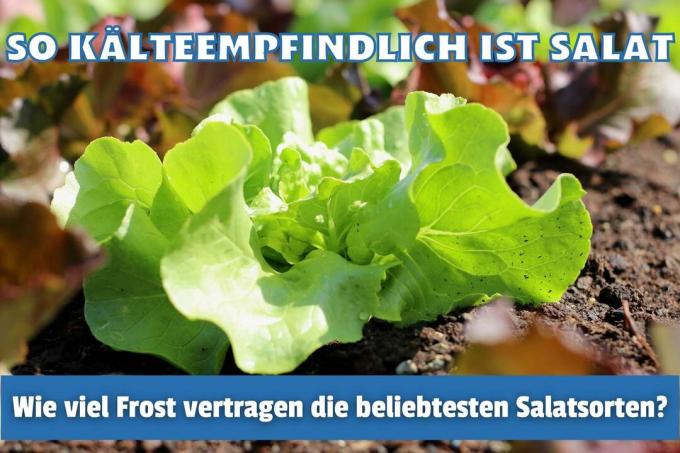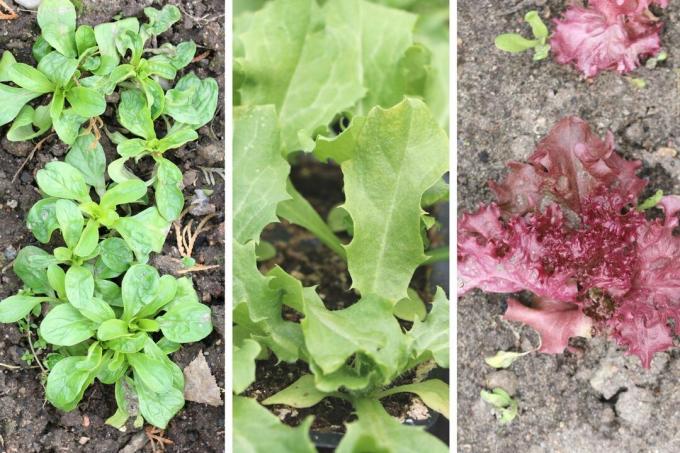
types of lettuce are in high demand for self-cultivation. Many of them also thrive in low temperatures. Read here how sensitive the most popular salads are to frost.
In a nutshell
- some lettuces also tolerate frosty temperatures
- Cold-resistant winter salads available
- However, selection is limited
- Lamb's lettuce and radicchio are the most insensitive to cold, iceberg lettuce very sensitive to cold
- Protection from the cold is important for the extended harvest season of frost-sensitive lettuce varieties
contents
- Cold sensitivity of popular salads
- frequently asked Questions
Cold sensitivity of popular salads
There are summer and winter salads, although not only the latter tolerate low temperatures. There are only a few winter salads that can withstand temperatures down to minus 15 degrees Celsius without any problems, but there are also some salads that are preferred in summer are harvested can stay in the bed in cooler weather or outside in winter, even if they are sensitive to cold are valid.
A notice: The maximum low temperatures mentioned for the individual types of lettuce are average values at which no danger is to be expected. They should be used as a guide. Only when the temperatures are significantly lower for a longer period of time should the lettuce be moved to a warmer location.

| type of lettuce | Insensitive to cold up to | planting time |
|---|---|---|
| Batavia | 10 degrees Celsius (salad very sensitive to cold) | mid-March to late July |
| Chicory | minus 10 degrees Celsius | mid-May to July |
| oak leaf lettuce | 6 degrees Celsius (conditionally sensitive to cold) | June |
| iceberg lettuce | 10 degrees Celsius (very sensitive to cold) | middle of May |
| endive | minus 6 degrees Celsius | mid-June to early August |
| Lamb's lettuce | minus 15 degrees Celsius | all year round |
| lettuce | 6 degrees Celsius (conditionally sensitive to cold) | mid-August to September |
| radicchio | minus 15 degrees Celsius | Mid-May to June (early varieties), early July (late varieties) |
| arugula | minus 6 degrees Celsius | March/early April |
| romaine lettuce | minus 5 degrees Celsius | from March to the end of July |
| cut lettuce | 6 degrees Celsius (conditionally sensitive to cold) | late March/early April |
| winter purslane | minus 10 degrees Celsius | September to February |
| sugarloaf | minus 8 degrees Celsius | mid/end of June |

Tip: With a cold frame, the salad season lasts almost all year round. In this way, you can grow winter lettuce late in the year and plant cold-sensitive lettuce in a sheltered place in spring.
frequently asked Questions
The proven and most robust lamb's lettuce varieties include "Valentin", "Jade" and "Dunkelgrüner Vollherziger".
Yes. A fleece is best suited for this. Cover the salads with it and they are less sensitive to cold. This protection against the cold allows you to increase the temperature by up to three or four degrees Celsius. In this way, lettuce can stay outdoors much longer and, ideally, can also be harvested.
no As a rule, the seeds are not cold germinators and, depending on the variety, require a temperature of between ten and a maximum of 20 degrees Celsius to germinate. However, the seeds of many frost-resistant specimens can be sown in the garden bed in early spring. They usually survive short-term lower temperatures unscathed, but only germinate at higher outside temperatures.



